Weekly Current Affairs (8th to 14th January 2025) Part - 2 | General Test Preparation for CUET UG - CUET Commerce PDF Download
India’s Engagement with Taliban
 Why in News?
Why in News?
- The recent talks held in Dubai between India’s Foreign Secretary and Afghanistan’s acting Foreign Minister signify a crucial moment amid global geopolitical instability. This marks India’s highest-level outreach to the Taliban rulers, aimed at safeguarding national and security interests.
Key Takeaways
- India has committed to expanding its humanitarian assistance to Afghanistan.
- Discussions included strengthening sports cooperation, particularly in cricket.
- Both sides agreed to promote the use of Chabahar port for trade and humanitarian aid delivery.
- India's security concerns were acknowledged by the Afghan side.
Additional Details
- Expanding Humanitarian Assistance: India has provided substantial aid, including 50,000 MT of wheat, 300 tons of medicines, winter clothing, and Covid-19 vaccine doses.
- Chabahar Port: This port is viewed as a vital gateway for facilitating trade and humanitarian efforts.
- Security Concerns: India has urged the Taliban to address threats from anti-India terrorist groups operating within Afghanistan.
Factors Influencing the Talks
- Changing Global Dynamics: Afghanistan's geopolitical landscape has shifted, particularly with the changing relations between the Taliban and Pakistan.
- Iran's Focus: Iran's attention has shifted towards deterring Israel, impacting its engagement with the Taliban.
- Russia's Position: Engaged in its own geopolitical challenges, Russia is seeking cooperation with the Taliban against shared threats.
- China's Role: China aims to leverage Afghanistan's resources for its Belt and Road Initiative, prompting India to act to protect its interests.
India's involvement in Afghanistan is not solely about immediate humanitarian needs but also about maintaining strategic influence in the region.
Importance of Afghanistan for India
- Bridge to Central Asia: Afghanistan provides India access to Central Asian resources while circumventing reliance on Pakistan and China.
- Countering Pakistan's Influence: By engaging in Afghanistan, India aims to enhance its strategic position in South Asia and Central Asia.
- Counter-Terrorism Efforts: India seeks to assert leadership in combating terrorism and extremism in the region.
- Development Engagement: India has invested significantly in Afghanistan, which has benefited local development and solidified ties.
Challenges for India’s Taliban Policy
- Strengthened Extremist Networks: The collapse of the democratic government has empowered extremist groups, posing a threat to India.
- Pakistan's Strategic Role: Pakistan views India’s presence in Afghanistan as a threat to its security strategy.
- Diplomatic Recognition: India's refusal to recognize the Taliban complicates its diplomatic efforts.
- Refugee Crisis: The influx of Afghan refugees raises concerns about security and integration in India.
Way Forward
- Focused Financial Investments: India should prioritize impactful projects in education and healthcare to support Afghanistan.
- Democratic Leadership Engagement: Engaging with Afghan civil society and advocating for human rights is crucial.
- Trade Access via SAARC: Leveraging regional platforms for trade could enhance economic ties.
- Narrative Building: Promoting awareness about Afghan citizens' needs and resuming educational opportunities will be vital.
In conclusion, India’s engagement with the Taliban is strategic, aimed at ensuring national security and fostering regional stability. As the situation evolves, India must navigate complex challenges while promoting mutual benefits and development in Afghanistan.
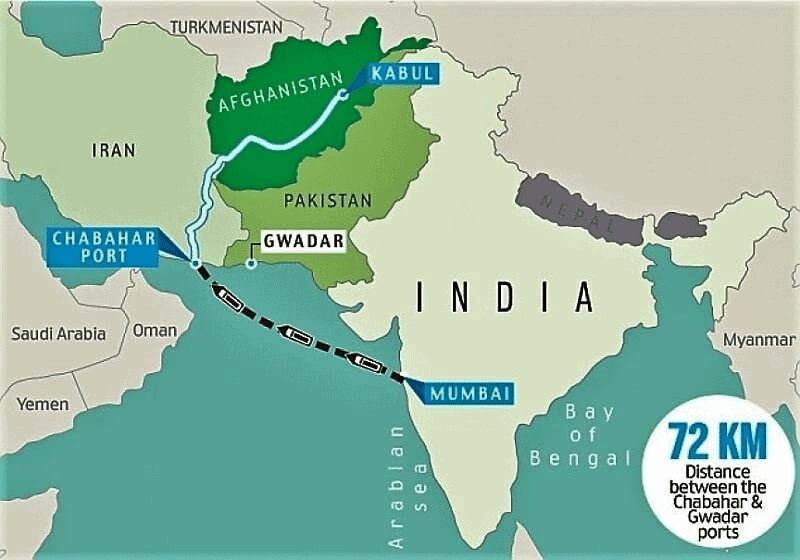
162nd Birth Anniversary of Swami Vivekananda
 Why in News?
Why in News?
- On 12 January, which marks the 162nd birth anniversary of the great spiritual leader, philosopher, and thinker Swami Vivekananda, the Prime Minister participated in the Viksit Bharat Young Leaders Dialogue 2025. This day is significant as it celebrates Vivekananda's contributions to society and his vision for the youth of India.
Key Takeaways
- The National Youth Day is celebrated to honor Swami Vivekananda's ideals and teachings.
- Swami Vivekananda is a pivotal figure in Indian spirituality and philosophy, emphasizing youth empowerment.
Additional Details
- What is the Viksit Bharat Young Leaders Dialogue? It is a platform designed to engage youth in nation-building efforts, aligning with the Prime Minister’s call to involve 1 lakh youth in politics without party affiliations.
- Participation: The event gathers 3,000 dynamic youth aged 15-29 years, selected through a merit-based process known as the Viksit Bharat Challenge.
- Thematic Focus: Young leaders will present their ideas on ten crucial areas for India's development, such as technology, sustainability, women empowerment, and agriculture.
Key Facts Regarding Swami Vivekananda
- Birth and Early Life: Born as Narendra Nath Datta in January 1863, he was the chief disciple of Ramakrishna Paramhansa.
- Name Change: In 1893, upon the request of Maharaja Ajit Singh of the Khetri State, he adopted the name ‘Vivekananda’, transitioning from his earlier name ‘Sachidananda’.
- Enlightenment Experience: In 1892, Vivekananda swam to a rock (later named Vivekananda Rock Memorial) in the Indian Ocean for meditation, spending three days there which led to his enlightenment.
Contributions to Philosophy and Society
- Philosophical Contributions: He introduced Indian philosophies of Vedanta and Yoga to the world.
- Spiritual Teachings: Vivekananda's teachings emphasize self-realization, compassion, and selfless service, drawing from the Upanishads and the Gita.
- Focus on Education: He advocated for man-making character-building education to regenerate the motherland.
Core Values Promoted by Swami Vivekananda
- Youth Empowerment: He urged the youth to commit to their goals and develop both mental and physical strength.
- Ethics: He taught that ethics is a vital code of conduct that guides individuals towards becoming good citizens.
- Universal Religion: Vivekananda viewed religion as a universal experience free from superstition, promoting tolerance and understanding.
- Rational Approach: He supported modern science and emphasized the importance of reason alongside faith.
- Nationalism: His nationalism was rooted in humanism and universalism, advocating for freedom, equality, and service to others.
Associated Organisations
- Ramakrishna Mission: Founded in 1897 to propagate ideals of service, education, and spiritual upliftment.
- Belur Math: Established in 1899, it became his permanent abode, symbolizing his life's work.
- International Address: He represented Hinduism at the Parliament of Religions in Chicago in 1893.
In conclusion, the Viksit Bharat Young Leaders Dialogue and the teachings of Swami Vivekananda highlight the importance of youth empowerment, ethical leadership, and holistic development. These initiatives align with national goals such as the National Youth Policy 2024, aiming to equip the youth with education, self-reliance, and rational thinking to shape India's sustainable future while honoring its rich spiritual and cultural heritage.
Mains Question: “A strong, rational, and ethical youth is the cornerstone of a developed India.” Comment in light of Vivekananda’s teachings.
Challenges and Developments Related with Denotified Tribes
Why in News?
- The Denotified Tribes (DNTs), Nomadic Tribes (NTs), and Semi-Nomadic Tribes (SNTs) in India are currently facing numerous challenges, particularly regarding the denial of caste certificates in most states. While the Indian Government has initiated the Scheme for Economic Empowerment of DNTs (SEED) to uplift these communities, various issues continue to foster discontent among them.
Key Takeaways
- The historical stigma from the Criminal Tribes Act of 1871 still impacts DNTs today.
- Many DNT, NT, and SNT communities remain unclassified, hindering access to welfare schemes.
- Implementation gaps in government policies contribute to the ongoing challenges faced by these communities.
- Lack of representation in leadership roles exacerbates their socio-economic issues.
Additional Details
- Historical Injustice: Communities labeled as criminal under British rule continue to face social and economic exclusion despite being denotified in 1952.
- Unclassified Communities: The Idate Commission (2017) identified 1,526 DNT, NT, and SNT communities, with 269 still unclassified, limiting access to necessary welfare benefits.
- Implementation Gaps: Recommendations from the Idate Commission remain unaddressed, and the SEED scheme has struggled with outreach and effectiveness.
- Lack of Representation: There is minimal representation of DNT communities in leadership roles, with no full-time chairperson for the Development and Welfare Board for DNTs, SNTs, and NTs.
Denotified Tribes, Nomadic Tribes, and Semi-Nomadic Tribes encompass a diverse range of communities, each with unique cultural and socio-economic conditions. The government needs to enhance policy implementation and representation to address the socio-economic issues faced by these communities effectively.
Landslide and Preventive Measures
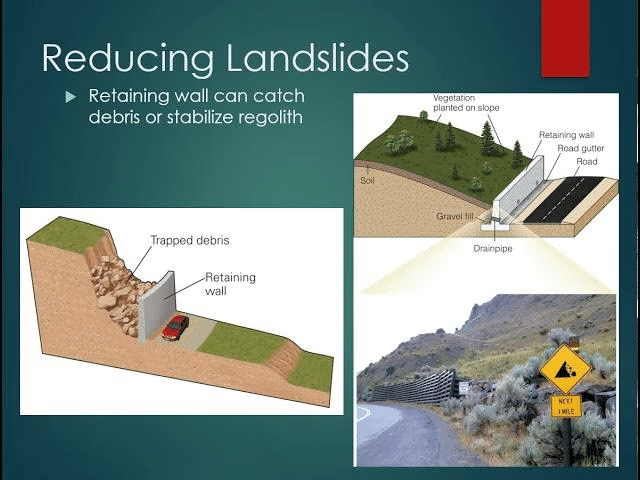 Why in News?
Why in News?
- A recent study published in Nature Natural Hazards in July 2024 highlights the critical need for improved disaster management strategies in areas prone to landslides, particularly in Wayanad district, Kerala. This region faced a devastating landslide caused by extreme rainfall and fragile ecological conditions.
Key Takeaways
- The study focuses on understanding rapid debris flows to enhance disaster management in vulnerable regions like Wayanad.
- Advanced modeling techniques were used to analyze the dynamics of debris flows during landslides.
- Vulnerability mapping is essential for identifying high-risk areas and implementing preventive measures.
Additional Details
- Research Methodology: The study employed advanced run-out modelling and Rapid Mass Movement Simulation (RAMMS) to track debris flow paths, speeds, pressures, and material accumulation during landslides.
- Key Findings:
- Significant debris accumulation was noted at lower elevations, posing future hazards downstream.
- The need for soil moisture monitoring stations was emphasized to establish early warning thresholds for timely evacuations.
- What are Landslides? A landslide is the downward movement of rock, soil, and debris on slopes, triggered by factors such as heavy rainfall, earthquakes, volcanic activity, human activities, and groundwater changes.
Landslides can take various forms, including slides, flows, spreads, topples, and falls, each characterized by different movement mechanisms.
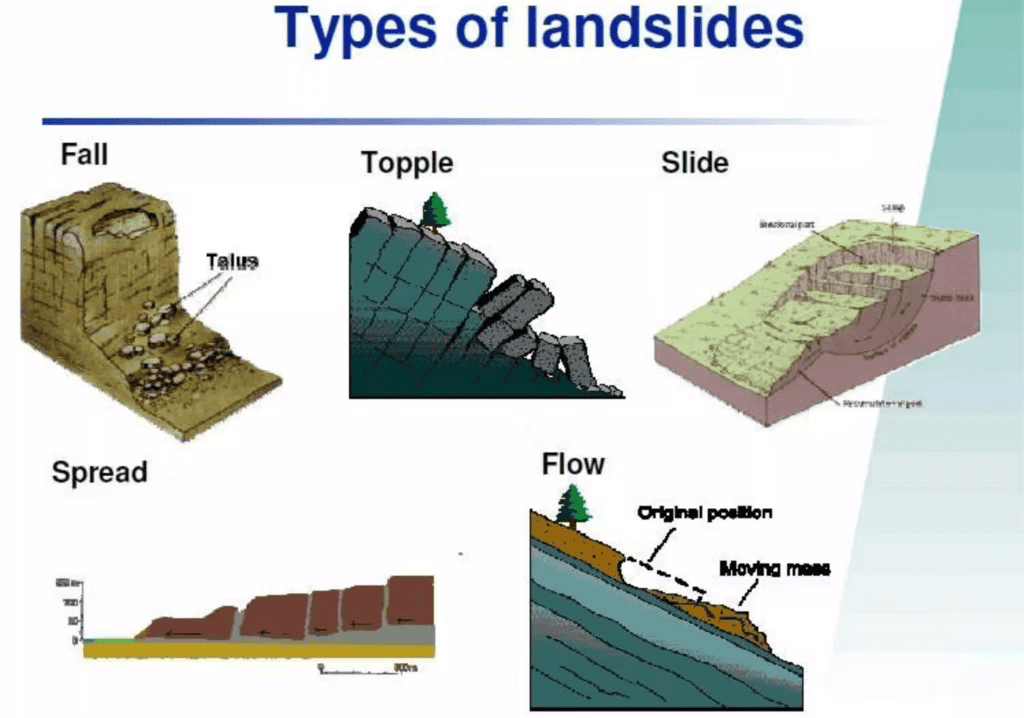
Landslide Prone Areas
According to the Landslide Atlas of India, approximately 0.42 million sq. km (12.6% of the land area) is prone to landslides:
- 0.18 million sq. km in the North East Himalaya
- 0.14 million sq. km in the North West Himalaya
- 0.09 million sq. km in the Western Ghats and Konkan hills
- 0.01 million sq. km in the Eastern Ghats of Andhra Pradesh
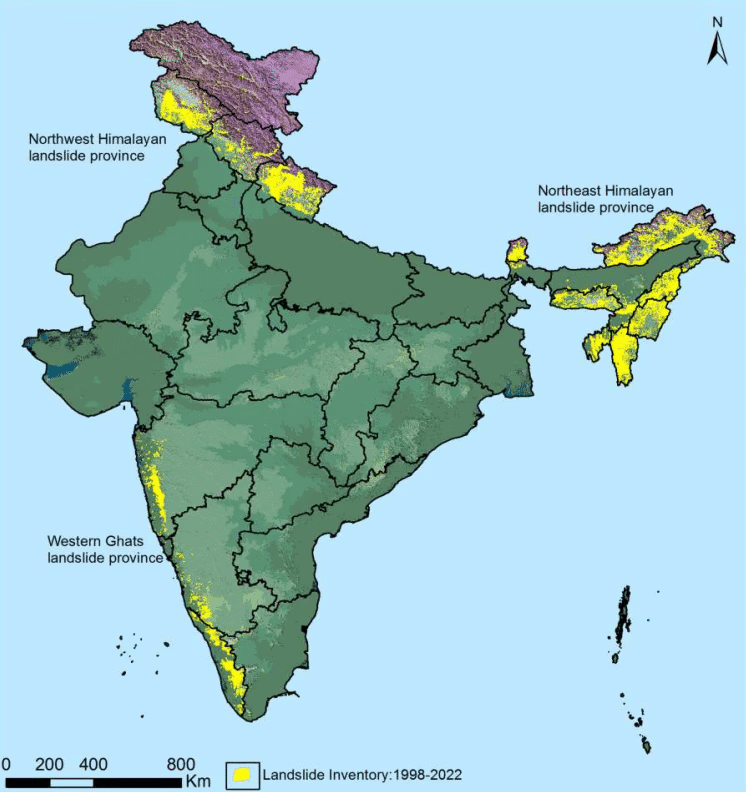
Causes of Landslides
Gravitational Forces: When gravity overcomes the strength of materials like rocks and soil, it leads to slope collapse.
- Natural Factors:
- Rainfall: Increases soil moisture, weakens cohesion, and adds weight to slopes.
- Earthquakes: Shake the ground, destabilizing slopes, especially in tectonically active areas.
Human Activities: Deforestation, mining, and urban development disrupt natural drainage and load distribution.
Geological Factors: Material composition and structure significantly affect slope stability.
Impacts of Landslides
- Human Life and Safety: Fast-moving landslides can be deadly, while slow-moving ones may cause long-term property damage.
- Damage to Infrastructure: Landslides can block roads and disrupt essential services.
- Cascading Effects: They can create debris dams that, if breached, lead to flooding.
- Economic Loss: Repairing infrastructure and providing humanitarian aid can be costly, affecting local economies.
- Environmental Impact: Landslides disrupt ecosystems, exacerbating erosion and soil degradation.
Government Initiatives to Mitigate Landslide Risks in India
- National Landslide Risk Management Strategy (2019): A comprehensive approach including hazard mapping, monitoring, and community involvement.
- Landslide Risk Mitigation Scheme (LRMS): Provides financial support for mitigation efforts in vulnerable states.
- Flood Risk Mitigation Scheme (FRMS): Includes pilot projects for flood shelters and early warning systems.
- National Guidelines: Cover risk management, structural measures, and community involvement.
- Landslide Atlas of India: Records landslide events, providing valuable insights for risk assessment.
Preventive Measures Against Landslide Hazards
Engineering Solutions:
- Slope stabilization using retaining walls and anchors.
- Grading and terracing to modify slopes and reduce instability.
- Drainage systems to control water flow and maintain soil strength.
Natural Solutions:
- Vegetation control to bind soil and reduce erosion.
- Water management techniques to slow runoff and encourage infiltration.
Monitoring Technologies: Instruments for measuring soil movement and rainfall intensity to provide early warnings.
Best Land Use Practices: Implementing erosion control measures and proper drainage systems.
In conclusion, there is an urgent need for enhanced disaster management strategies to mitigate landslide risks, particularly in vulnerable areas like Wayanad. Implementing engineering solutions, adopting natural methods, and utilizing early warning systems are essential steps to reduce hazards and improve resilience against climate change-induced extreme rainfall events.
Mains Question:
- Discuss the causes and impacts of landslides in India. How can disaster management strategies be improved?
Iran’s Capital Shift to Makran and Alexander’s Legacy
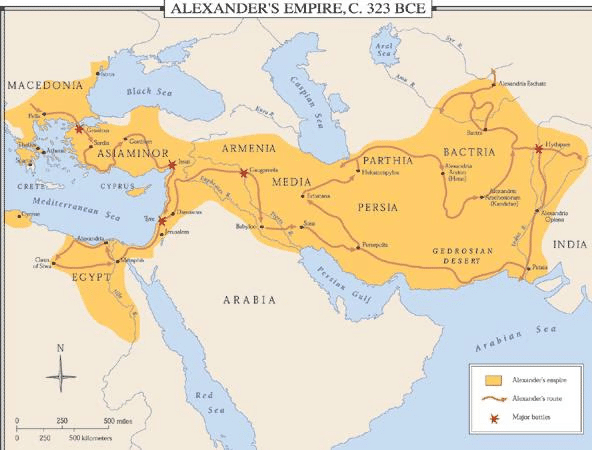 Why in News?
Why in News?
- Iran plans to relocate its capital from Tehran to the southern Makran coastal region due to economic and ecological concerns. Historically, this region was notable as the area where Alexander the Great lost a significant portion of his army during his retreat to Macedonia after his invasion of India (327–325 BCE).
Key Takeaways
- Iran aims to move its capital to address issues such as overpopulation, pollution, and water scarcity in Tehran.
- Tehran has served as Iran's capital for over 200 years, established during Agha Mohammad Khan's reign.
- Makran's strategic location offers potential economic growth, especially in maritime trade.
- Alexander the Great's invasion of India marked a significant historical interaction between ancient Europe and South Asia.
Additional Details
- Historical Context: Tehran has been Iran's capital for over 200 years, established during the Qajar dynasty (1794-1925).
- Planned Relocation: The relocation has been considered since Mahmoud Ahmadinejad's presidency in the early 2000s due to Tehran's deteriorating living conditions.
- Strategic Importance of Makran: Its proximity to the Gulf of Oman allows for enhanced national economic prospects and access to Iran's petroleum reserves.
- About Alexander: A king of Macedonia who conquered a vast empire, remaining undefeated in battle and known as one of history's greatest military leaders.
- Political Landscape of India: The region was divided into various monarchies and tribal republics, with key figures like Ambhi of Taxila and Porus failing to unite against Alexander.
- Entry through Khyber Pass: Alexander entered India after conquering Kabul, reaching the Indus River.
- Key Events:
- Battle of the Hydaspes: Alexander encountered fierce resistance from Porus but ultimately formed an alliance after defeating him.
- Halting at the Hyphasis (Beas) River: Alexander's troops, fearing a larger Indian force, persuaded him to retreat.
- Forced Retreat: Many soldiers perished during the treacherous march through the Gedrosia (Makran Desert), leading to immense suffering.
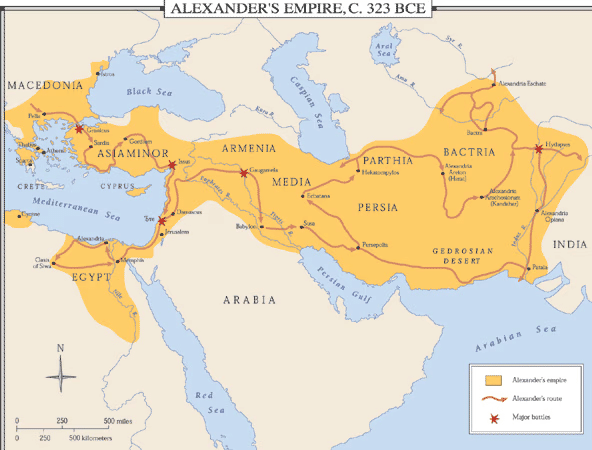
Alexander's invasion had profound effects, establishing the first major contact between ancient Europe and India, fostering cultural exchanges, and influencing trade routes. The invasion also paved the way for the Mauryan Empire's expansion and left a lasting impact on the region's cultural and political landscape.
In conclusion, Iran's plan to relocate its capital to Makran underscores its efforts to tackle pressing ecological and economic challenges while capitalizing on strategic advantages. Simultaneously, Alexander's invasion of India reshaped the region's dynamics, facilitating cultural and trade exchanges that have influenced both Greek and Indian civilizations for centuries.
Mains Question:
- Analyze the significance of Alexander the Great’s invasion of India in shaping the political, cultural, and geographical landscapes of South Asia.
Watershed Development Component 2.0 of PMKSY
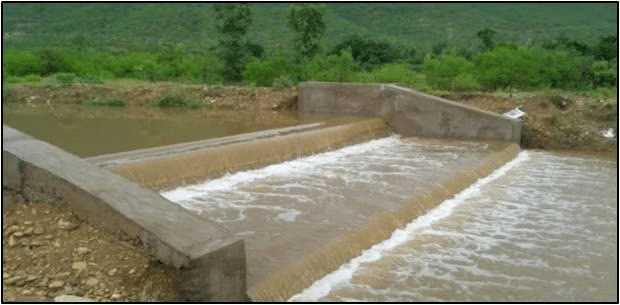 Why in News?
Why in News?
- The Ministry of Rural Development has approved 56 new projects under the Prime Minister Krishi Sinchayee Yojna (PMKSY-WDC 2.0) in ten of the best-performing states. The selected states include Rajasthan, Madhya Pradesh, Karnataka, Odisha, Tamil Nadu, Assam, Nagaland, Himachal Pradesh, Uttarakhand, and Sikkim. These projects aim to cover approximately 2.8 lakh hectares of degraded land.
Key Takeaways
- The PMKSY-WDC 2.0 initiative focuses on conserving water and soil resources.
- Originally established as the Integrated Watershed Management Programme (IWMP) in 2009-10, it was merged into PMKSY-WDC in 2015-16.
- The current phase runs from 2021 to 2026, with enhanced targets and updated guidelines.
Additional Details
Objectives:The program aims to:
- Enhance: Productivity of rainfed and degraded lands through integrated watershed management.
- Strengthen: Community institutions to support livelihoods and ensure watershed sustainability.
- Boost: Project efficiency with cross-learning and incentives.
Targets: The scheme aims to cover 49.50 lakh hectares of degraded land from 2021 to 2026, with the rejuvenation of springsheds as a new activity.
Approach: Focus on improving water productivity rather than just quantity, transitioning from mechanical treatments to biological measures, and promoting diverse agricultural practices such as horticulture, fisheries, apiculture, and animal husbandry.
This initiative represents a significant step towards sustainable land and water management, aiming for ecological restoration and improved livelihoods in rural areas.
|
194 videos|842 docs|2235 tests
|





















